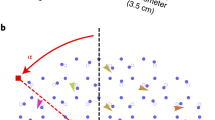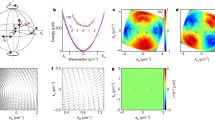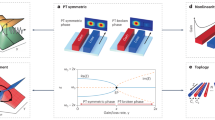Abstract
Weyl points are isolated degeneracies in reciprocal space that are monopoles of the Berry curvature. This topological charge makes them inherently robust to Hermitian perturbations of the system. However, non-Hermitian effects, usually inaccessible in condensed-matter systems, are an important feature of photonic systems, and when added to an otherwise Hermitian Weyl material have been predicted to spread the Berry charge of the Weyl point out onto a ring of exceptional points, creating a Weyl exceptional ring and fundamentally altering its properties. Here, we observe the implications of the Weyl exceptional ring using real-space measurements of an evanescently coupled bipartite optical waveguide array by probing its effects on the Fermi arc surface states and bulk diffraction properties of the two constituent sublattices in an experimental realization of a distributed Berry charge in a topological material.
This is a preview of subscription content, access via your institution
Access options
Access Nature and 54 other Nature Portfolio journals
Get Nature+, our best-value online-access subscription
$29.99 / 30 days
cancel any time
Subscribe to this journal
Receive 12 print issues and online access
$209.00 per year
only $17.42 per issue
Buy this article
- Purchase on Springer Link
- Instant access to full article PDF
Prices may be subject to local taxes which are calculated during checkout




Similar content being viewed by others
Data availability
The data that support the findings of this study are available from the corresponding author on reasonable request.
Code availability
The code used in this study is available from the corresponding author on reasonable request.
References
Hasan, M. Z. & Kane, C. L. Colloquium: topological insulators. Rev. Mod. Phys. 82, 3045–3067 (2010).
Ozawa, T. et al. Topological photonics. Rev. Mod. Phys. 91, 015006 (2019).
Haldane, F. D. M. & Raghu, S. Possible realization of directional optical waveguides in photonic crystals with broken time-reversal symmetry. Phys. Rev. Lett. 100, 013904 (2008).
Wang, Z., Chong, Y., Joannopoulos, J. D. & Soljačić, M. Observation of unidirectional backscattering-immune topological electromagnetic states. Nature 461, 772–775 (2009).
Umucallar, R. O. & Carusotto, I. Artificial gauge field for photons in coupled cavity arrays. Phys. Rev. A 84, 043804 (2011).
Hafezi, M., Demler, E. A., Lukin, M. D. & Taylor, J. M. Robust optical delay lines with topological protection. Nat. Phys. 7, 907–912 (2011).
Fang, K., Yu, Z. & Fan, S. Realizing effective magnetic field for photons by controlling the phase of dynamic modulation. Nat. Photon. 6, 782–787 (2012).
Kraus, Y. E., Lahini, Y., Ringel, Z., Verbin, M. & Zilberberg, O. Topological states and adiabatic pumping in quasicrystals. Phys. Rev. Lett. 109, 106402 (2012).
Kitagawa, T. et al. Observation of topologically protected bound states in photonic quantum walks. Nat. Commun. 3, 1872 (2012).
Rechtsman, M. C. et al. Photonic Floquet topological insulators. Nature 496, 196–200 (2013).
Khanikaev, A. B. et al. Photonic topological insulators. Nat. Mater. 12, 233–239 (2013).
Hafezi, M., Mittal, S., Fan, J., Migdall, A. & Taylor, J. M. Imaging topological edge states in silicon photonics. Nat. Photon. 7, 1001–1005 (2013).
Wan, X., Turner, A. M., Vishwanath, A. & Savrasov, S. Y. Topological semimetal and Fermi-arc surface states in the electronic structure of pyrochlore iridates. Phys. Rev. B 83, 205101 (2011).
Yang, K.-Y., Lu, Y.-M. & Ran, Y. Quantum Hall effects in a Weyl semimetal: possible application in pyrochlore iridates. Phys. Rev. B 84, 075129 (2011).
Lu, L., Fu, L., Joannopoulos, J. D. & Soljačić, M. Weyl points and line nodes in gyroid photonic crystals. Nat. Photon. 7, 294–299 (2013).
Xu, S.-Y. et al. Discovery of a Weyl fermion semimetal and topological Fermi arcs. Science 349, 613–617 (2015).
Lu, L. et al. Experimental observation of Weyl points. Science 349, 622–624 (2015).
Lv, B. Q. et al. Observation of Weyl nodes in TaAs. Nat. Phys. 11, 724–727 (2015).
Yang, L. X. et al. Weyl semimetal phase in the non-centrosymmetric compound TaAs. Nat. Phys. 11, 728–732 (2015).
Soluyanov, A. A. et al. Type-II Weyl semimetals. Nature 527, 495–498 (2015).
Xiao, M., Chen, W.-J., He, W.-Y. & Chan, C. T. Synthetic gauge flux and Weyl points in acoustic systems. Nat. Phys. 11, 920–924 (2015).
Chen, W.-J., Xiao, M. & Chan, C. T. Photonic crystals possessing multiple Weyl points and the experimental observation of robust surface states. Nat. Commun. 7, 13038 (2016).
Lin, Q., Xiao, M., Yuan, L. & Fan, S. Photonic Weyl point in a two-dimensional resonator lattice with a synthetic frequency dimension. Nat. Commun. 7, 13731 (2016).
Xiao, M., Lin, Q. & Fan, S. Hyperbolic Weyl point in reciprocal chiral metamaterials. Phys. Rev. Lett. 117, 057401 (2016).
Gao, W. et al. Photonic Weyl degeneracies in magnetized plasma. Nat. Commun. 7, 12435 (2016).
Fang, C., Lu, L., Liu, J. & Fu, L. Topological semimetals with helicoid surface states. Nat. Phys. 12, 936–941 (2016).
Noh, J. et al. Experimental observation of optical Weyl points and Fermi arc-like surface states. Nat. Phys. 13, 611 (2017).
Goi, E., Yue, Z., Cumming, B. P. & Gu, M. Observation of type I photonic Weyl points in optical frequencies. Laser Photonics Rev. 12, 1700271 (2018).
Berry, M. V. Quantal phase factors accompanying adiabatic changes. Proc. R. Soc. Lond. A 392, 45–57 (1984).
Kato, T. Perturbation Theory for Linear Operators 2nd edn (Springer, 1995).
Bender, C. M., Boettcher, S. & Meisinger, P. N. PT-symmetric quantum mechanics. J. Math. Phys. 40, 2201–2229 (1999).
Bender, C. M., Brody, D. C. & Jones, H. F. Complex extension of quantum mechanics. Phys. Rev. Lett. 89, 270401 (2002).
Makris, K. G., El-Ganainy, R., Christodoulides, D. N. & Musslimani, Z. H. Beam dynamics in PT symmetric optical lattices. Phys. Rev. Lett. 100, 103904 (2008).
Lin, Z. et al. Unidirectional invisibility induced by PT-symmetric periodic structures. Phys. Rev. Lett. 106, 213901 (2011).
Peng, B. et al. Parity-time-symmetric whispering-gallery microcavities. Nat. Phys. 10, 394–398 (2014).
Hodaei, H., Miri, M.-A., Heinrich, M., Christodoulides, D. N. & Khajavikhan, M. Parity-time-symmetric microring lasers. Science 346, 975–978 (2014).
Feng, L., Wong, Z. J., Ma, R.-M., Wang, Y. & Zhang, X. Single-mode laser by parity-time symmetry breaking. Science 346, 972–975 (2014).
Lawrence, M. et al. Manifestation of PT symmetry breaking in polarization space with terahertz metasurfaces. Phys. Rev. Lett. 113, 093901 (2014).
Cerjan, A. & Fan, S. Achieving arbitrary control over pairs of polarization states using complex birefringent metamaterials. Phys. Rev. Lett. 118, 253902 (2017).
Zhou, H. et al. Observation of bulk Fermi arc and polarization half charge from paired exceptional points. Science 359, 1009–1012 (2018).
Lin, Z., Pick, A., Lončar, M. & Rodriguez, A. W. Enhanced spontaneous emission at third-order Dirac exceptional points in inverse-designed photonic crystals. Phys. Rev. Lett. 117, 107402 (2016).
Pick, A., Lin, Z., Jin, W. & Rodriguez, A. W. Enhanced nonlinear frequency conversion and Purcell enhancement at exceptional points. Phys. Rev. B 96, 224303 (2017).
Zeuner, J. M. et al. Observation of a topological transition in the bulk of a non-Hermitian system. Phys. Rev. Lett. 115, 040402 (2015).
Lee, T. E. Anomalous edge state in a non-Hermitian lattice. Phys. Rev. Lett. 116, 133903 (2016).
Leykam, D., Bliokh, K. Y., Huang, C., Chong, Y. & Nori, F. Edge modes, degeneracies, and topological numbers in non-Hermitian systems. Phys. Rev. Lett. 118, 040401 (2017).
Weimann, S. et al. Topologically protected bound states in photonic parity-time-symmetric crystals. Nat. Mater. 16, 433–438 (2017).
Shen, H., Zhen, B. & Fu, L. Topological band theory for non-Hermitian hamiltonians. Phys. Rev. Lett. 120, 146402 (2018).
Kunst, F. K., Edvardsson, E., Budich, J. C. & Bergholtz, E. J. Biorthogonal bulk-boundary correspondence in non-Hermitian systems. Phys. Rev. Lett. 121, 026808 (2018).
Yao, S. & Wang, Z. Edge states and topological invariants of non-Hermitian systems. Phys. Rev. Lett. 121, 086803 (2018).
Gong, Z. et al. Topological phases of non-Hermitian systems. Phys. Rev. X 8, 031079 (2018).
Kremer, M. et al. Demonstration of a two-dimensional PT-symmetric crystal. Nat. Commun. 10, 435 (2019).
Xu, Y., Wang, S.-T. & Duan, L.-M. Weyl exceptional rings in a three-dimensional dissipative cold atomic gas. Phys. Rev. Lett. 118, 045701 (2017).
Cerjan, A., Xiao, M., Yuan, L. & Fan, S. Effects of non-Hermitian perturbations on Weyl hamiltonians with arbitrary topological charges. Phys. Rev. B 97, 075128 (2018).
Szameit, A. & Nolte, S. Discrete optics in femtosecond-laser-written photonic structures. J. Phys. B 43, 163001 (2010).
Schomerus, H. & Wiersig, J. Non-Hermitian-transport effects in coupled-resonator optical waveguides. Phys. Rev. A 90, 053819 (2014).
Yariv, A. & Yeh, P. Optical Waves in Crystals: Propagation and Control of Laser Radiation (Wiley, 1984).
Leykam, D., Rechtsman, M. & Chong, Y. Anomalous topological phases and unpaired Dirac cones in photonic floquet topological insulators. Phys. Rev. Lett. 117, 013902 (2016).
Acknowledgements
The authors thank J. Noh for discussions about experimental techniques. M.C.R. and A.C. acknowledge support from the National Science Foundation under grants ECCS-1509546 and DMS-1620422 as well as the Packard Foundation via fellowship no. 2017-66821, and the Charles E. Kaufman foundation under grant no. KA2017-91788. K.P.C., S.H. and M.W. acknowledge National Science Foundation grants ECCS-1509199 and DMS-1620218. Y.D.C. is supported by Singapore MOE Academic Research Fund Tier 2 Grants MOE2015-T2-2-008 and MOE2016-T2-1-128, and Singapore MOE Academic Research Fund Tier 3 Grant MOE2016-T3-1-006.
Author information
Authors and Affiliations
Contributions
A.C. conceived of the idea, carried out the experimental measurements, and performed the data analysis and numerical simulations. A.C. and M.C.R. designed the experiments. A.C., Y.D.C. and M.C.R. performed the theoretical analysis and wrote the manuscript. S.H. and M.W. developed the laser fabrication process and characterized the samples under the supervision of K.P.C. The project was supervised by M.C.R. All authors contributed to discussions and to finalizing the manuscript.
Corresponding author
Ethics declarations
Competing interests
The authors declare no competing interests.
Additional information
Publisher’s note: Springer Nature remains neutral with regard to jurisdictional claims in published maps and institutional affiliations.
Supplementary information
Supplementary Information
Supplementary derivations and discussion, Supplementary Figs. 1–4 and Supplementary references 1–14.
Rights and permissions
About this article
Cite this article
Cerjan, A., Huang, S., Wang, M. et al. Experimental realization of a Weyl exceptional ring. Nat. Photonics 13, 623–628 (2019). https://doi.org/10.1038/s41566-019-0453-z
Received:
Accepted:
Published:
Issue Date:
DOI: https://doi.org/10.1038/s41566-019-0453-z
This article is cited by
-
Observation of continuum Landau modes in non-Hermitian electric circuits
Nature Communications (2024)
-
Hyperbolic photonic topological insulators
Nature Communications (2024)
-
Design of unidirectional and tunable channels in two-dimensional photonic crystal composed of local PT symmetric structure
Journal of Optics (2024)
-
Analysis of Hermitian and non-Hermitian diabolic points and exceptional rings in parity-time symmetric ZRC and RLC dimers
Optical and Quantum Electronics (2024)
-
Recent progress of exciton transport in two-dimensional semiconductors
Nano Convergence (2023)



